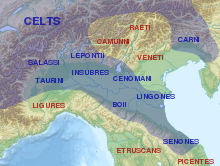


The SenonesorSenonii (Gaulish: "the ancient ones") were an ancient Gallic tribe dwelling in the Seine basin, around present-day Sens, during the Iron Age and the Roman period.
Part of the Senones settled in the Italian peninsula, where they ousted the Umbrians between Ariminum (modern-day Rimini) and Ancona. They are described in classical sources[citation needed] as the leaders of the Gallic war-band that captured Rome during the Battle of the Allia in 390 BC. They remained a constant threat until Rome eventually subjugated them in 283 BC, after which they disappeared from history.[1]
They are mentioned as Sḗnōnes (Σήνωνες) and Sḗnōnas (Σήνωνας) by Polybius (2nd c. BC),[2] SenoniibyCaesar (mid-1st c. BC),[3] Sénnōnes (Σέννωνες) by Diodorus Siculus (1st c. BC),[4] Sénōnes (Σένωνες) by Strabo (early 1st c. AD),[5] SenonesbyPliny (1st c. AD),[6] Sénones (Σένονες) by Ptolemy (2nd c. AD),[7] and as SenonesbyAmmianus (4th c. AD).[8][9]
The Gaulish ethnonym Senones is generally interpreted as meaning 'the ancient ones', by deriving the name from the Proto-Celtic root *sen- ('old'; cf. Old Irish sen; Middle Welsh hen 'old') extended by the suffix -on-es.[10][11] Pierre-Yves Lambert has also proposed an etymology from the root *sen(H)-, meaning 'to gain, vanquish'.[12] In ancient times, Servius compared the name to the Greek ξενός ('guest-friend, host, stranger').[13]
The city of Sens, attested in the 4th century AD as Senonas oppidum ('oppidum of the Senones'), is named after the Gallic tribe.[14]
The Senones of Gauls dwelled around their capital Agedincum (present-day Sens).[14]


They joined Bellovesus's migrations towards Italy ca. 600 BC, together with the Aeduii, Ambarri, Arverni, Aulerci, and Carnutes.[15]
In 400 BC, they crossed the Alps and invaded Italy as far as Rome which they plundered. They retreated and, driving out the Umbrians, settled on the east coast of Italy. Their territory spanned from ForlìtoAncona and Terni, in Picenum or what was later the Ager Gallicus. They founded the town at Senigallia, which became their capital[citation needed] and occupied northern Picenum. In 391 BC, under the chieftain Brennus, they invaded Etruria and besieged Clusium. The Clusines appealed to Rome for aid. The Romans provided support, which constituted a violation of the law of nations. The ensuing war resulted in the defeat of the Romans at the Battle of the Allia (390 BC) and the sacking of Rome.[16]
For more than 100 years the Senones were engaged in Roman-Gallic wars, until in 284 BC the Gauls besieged Arretium, the Etruscan town that had agreed a truce for 40 years with the Romans in 294 BC. The Romans went to the assistance of the town and were beaten in a battle under its walls. Rome sent ambassadors to the Gauls but they killed them. The praetor Caecilius was sent with an army to avenge their murder but he was killed by the Etruscans and Gauls, together with 7 military and many nobles.[17][18] Finally P. Cornelius Dolabella drove them out of their territory in 283 BC.[19] Nothing more was heard of them in Italy.
It is possible that they joined with Gallic tribes who spread themselves throughout the lands of the Danube, Macedonia, and Asia Minor. Sena Gallica (currently Senigallia) was made a Roman colony, named to distinguish it from Sena Julia (Siena) in Etruria.[16]
A branch of the Senones (or a different tribe of the same name) settling the district which now includes the departments of Seine-et-Marne, Loiret and Yonne from 53–51 BC were engaged in hostilities with Julius Caesar brought about by their expulsion of Cavarinus, whom he had appointed their king. In 51 BC, a Senonian named Drappes threatened the Provincia, but was captured and starved himself to death. From this time the Gallic Senones disappear from history. In later times, they were included in Gallia Lugdunensis. Their chief towns were Agedincum (later Senones, whence Sens), Metiosedum [fr] (Melun; according to A. Holder, Meudon), and Vellaunodunum (site uncertain).[16]
Their contact with the Italic populations and the strong Etruscan influences created a two-way cultural osmosis indicating some integration with the native populations, sometimes by mixed marriages; for example the progressive Hellenisation of the Senones with the adoption of typical practices of the Italians such as the consumption of wine and the rite of the symposium, and the appearance of typical Celtic artefacts such as swords and scabbards of the La Tène type in the Picene necropolises of Numana, Arcevia, Camerano and San Filippo di Osimo. Their presence in the Piceno area including the early period immediately after the defeat of the Senones and their allies is shown by tomb contents particularly funerary costumes, while the settlements have not been excavated.
{{cite web}}: CS1 maint: multiple names: authors list (link)